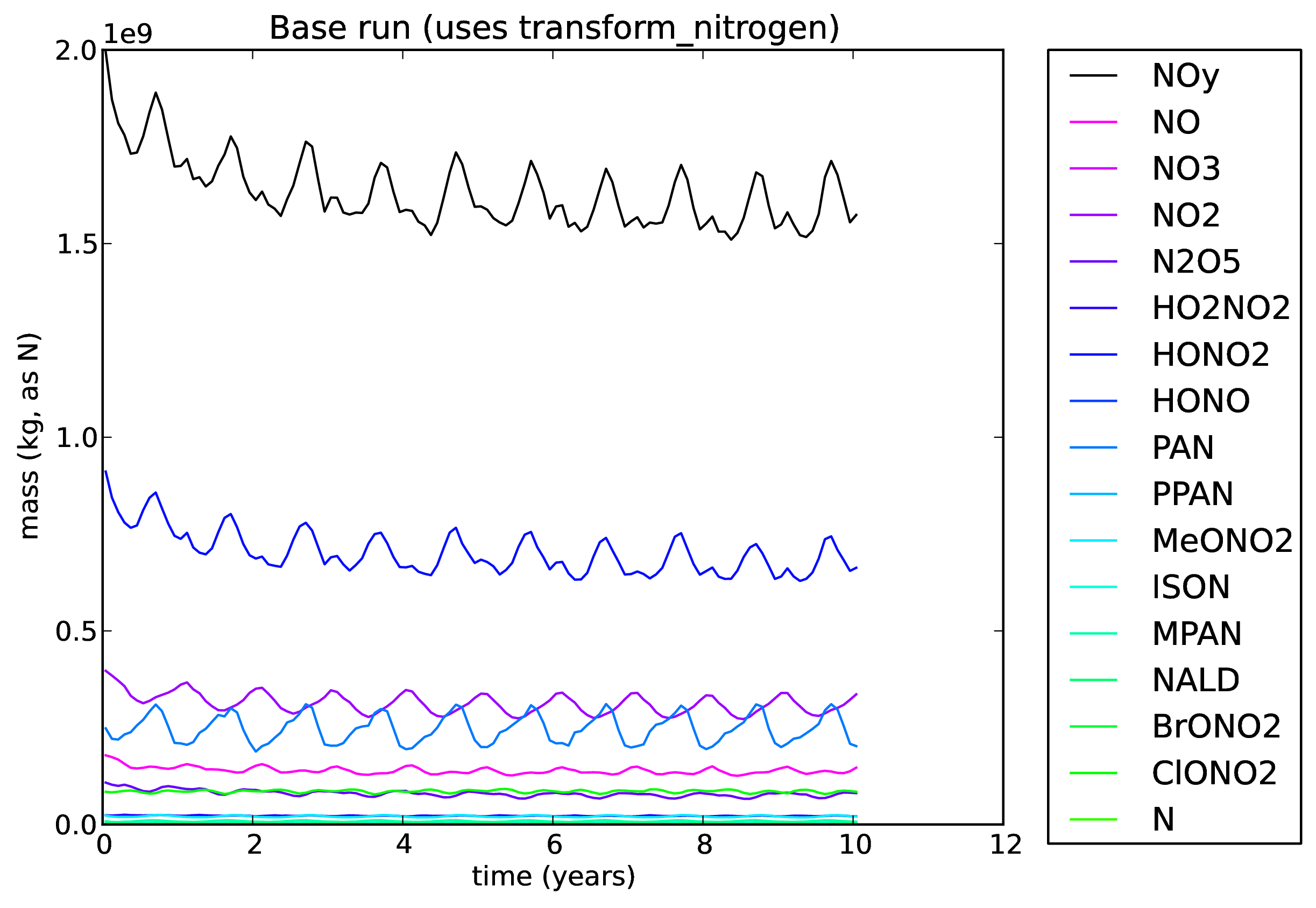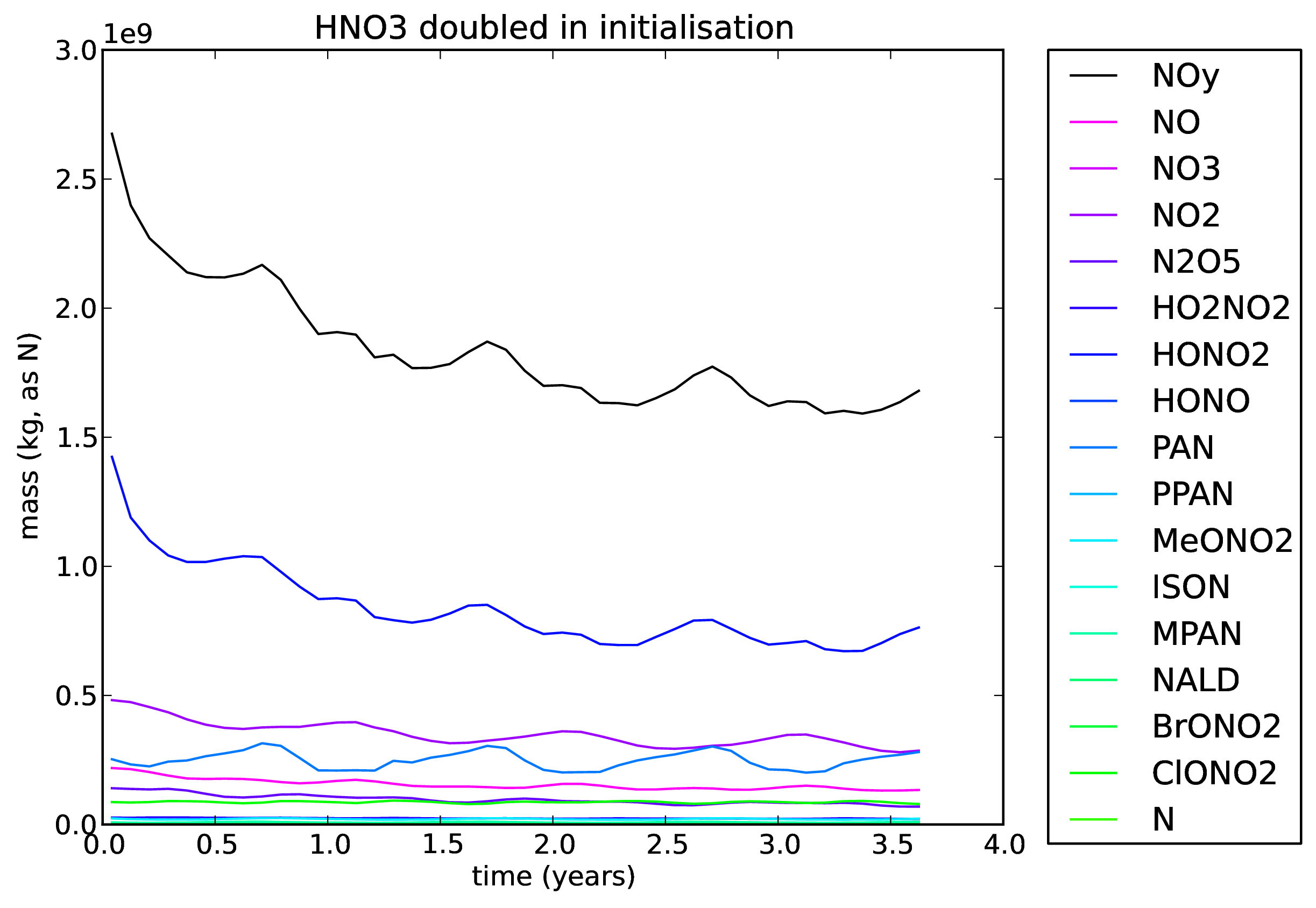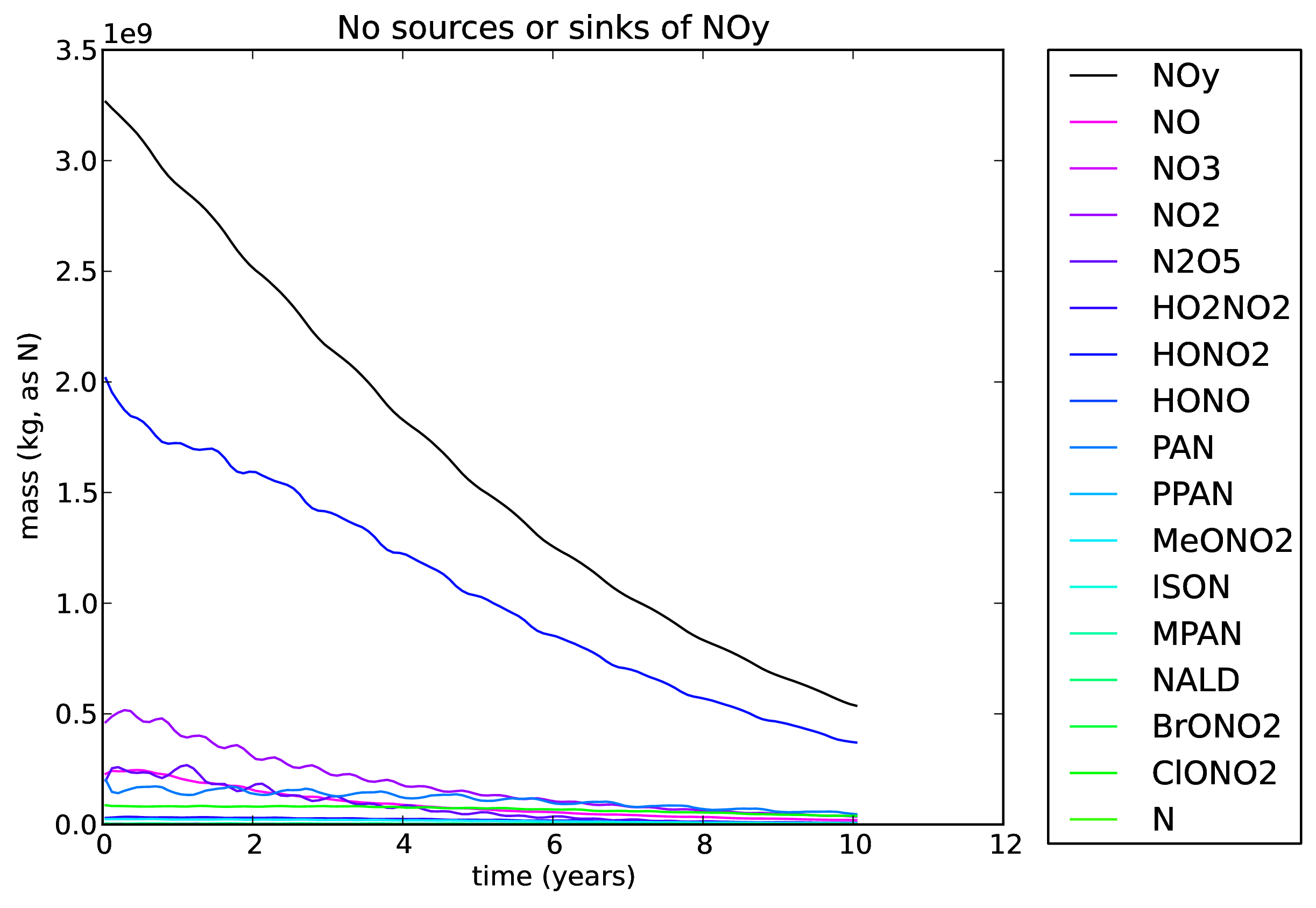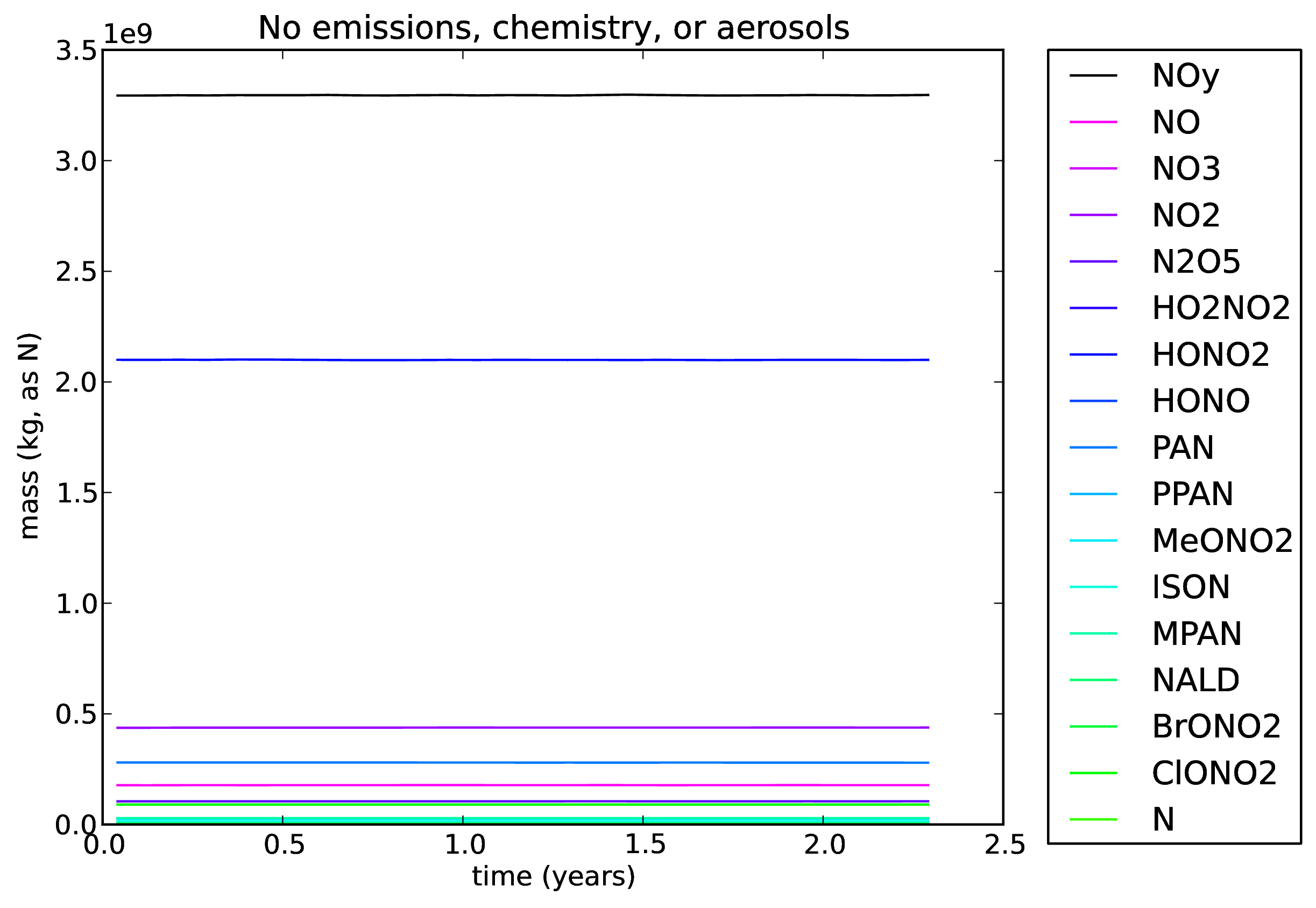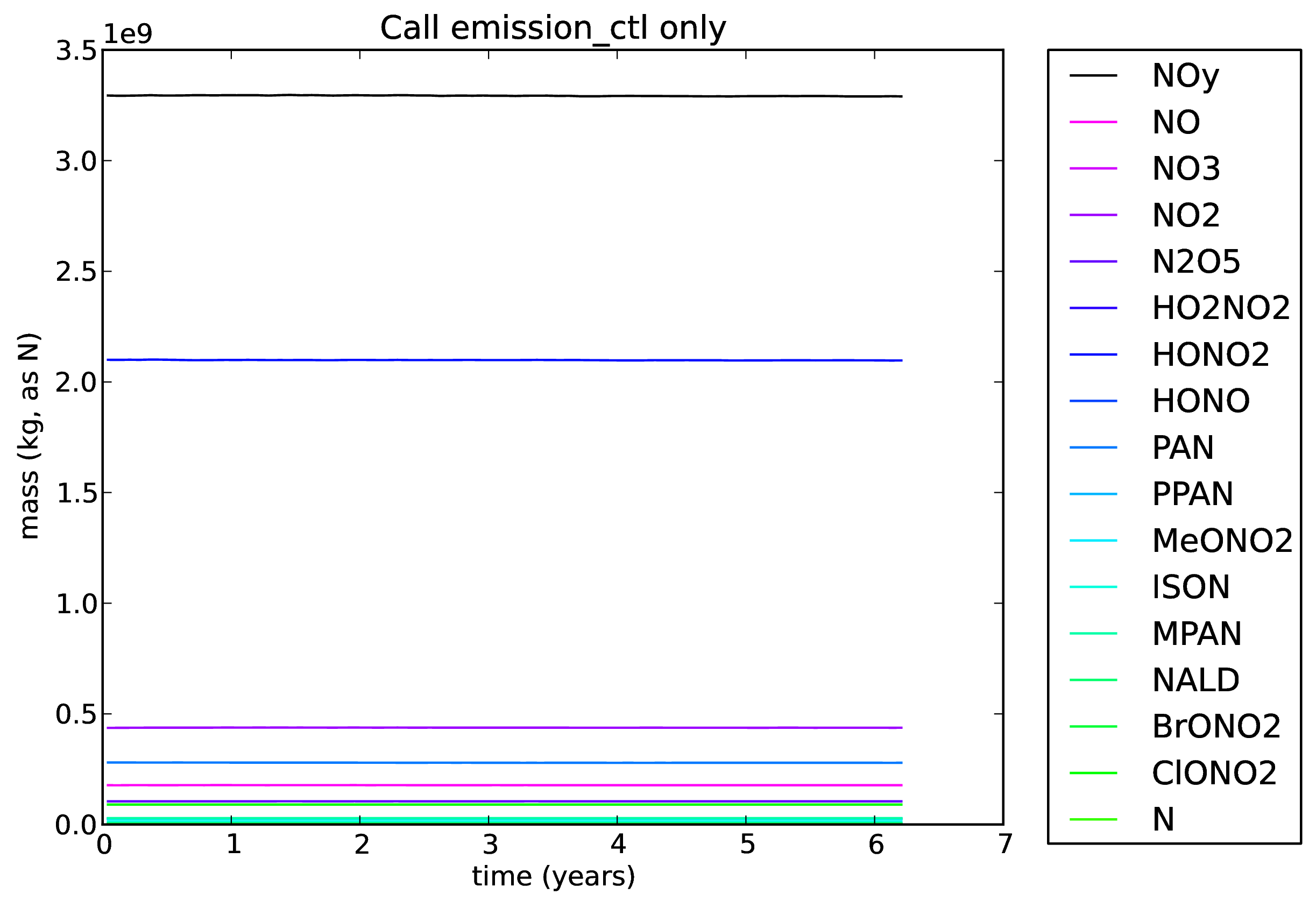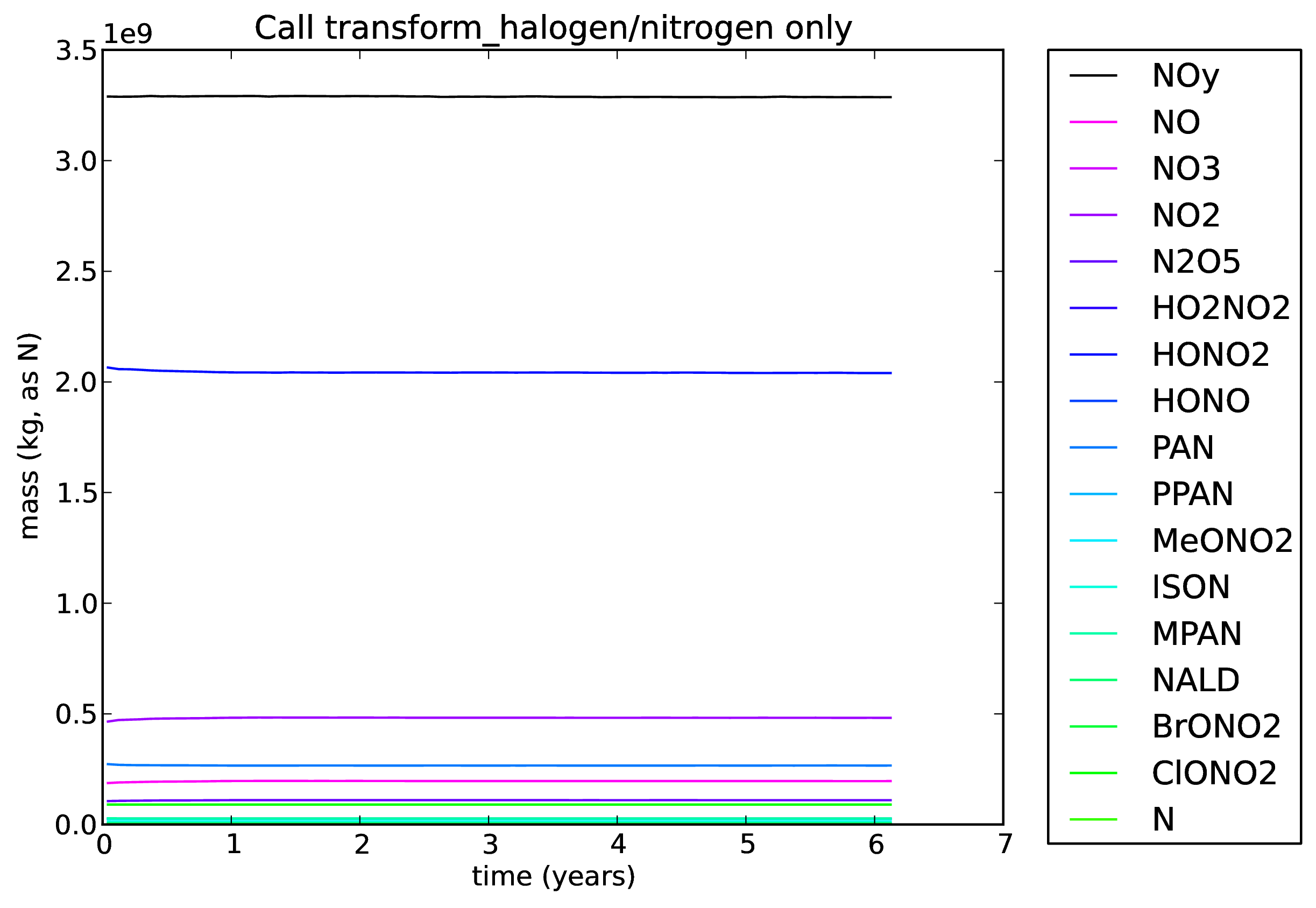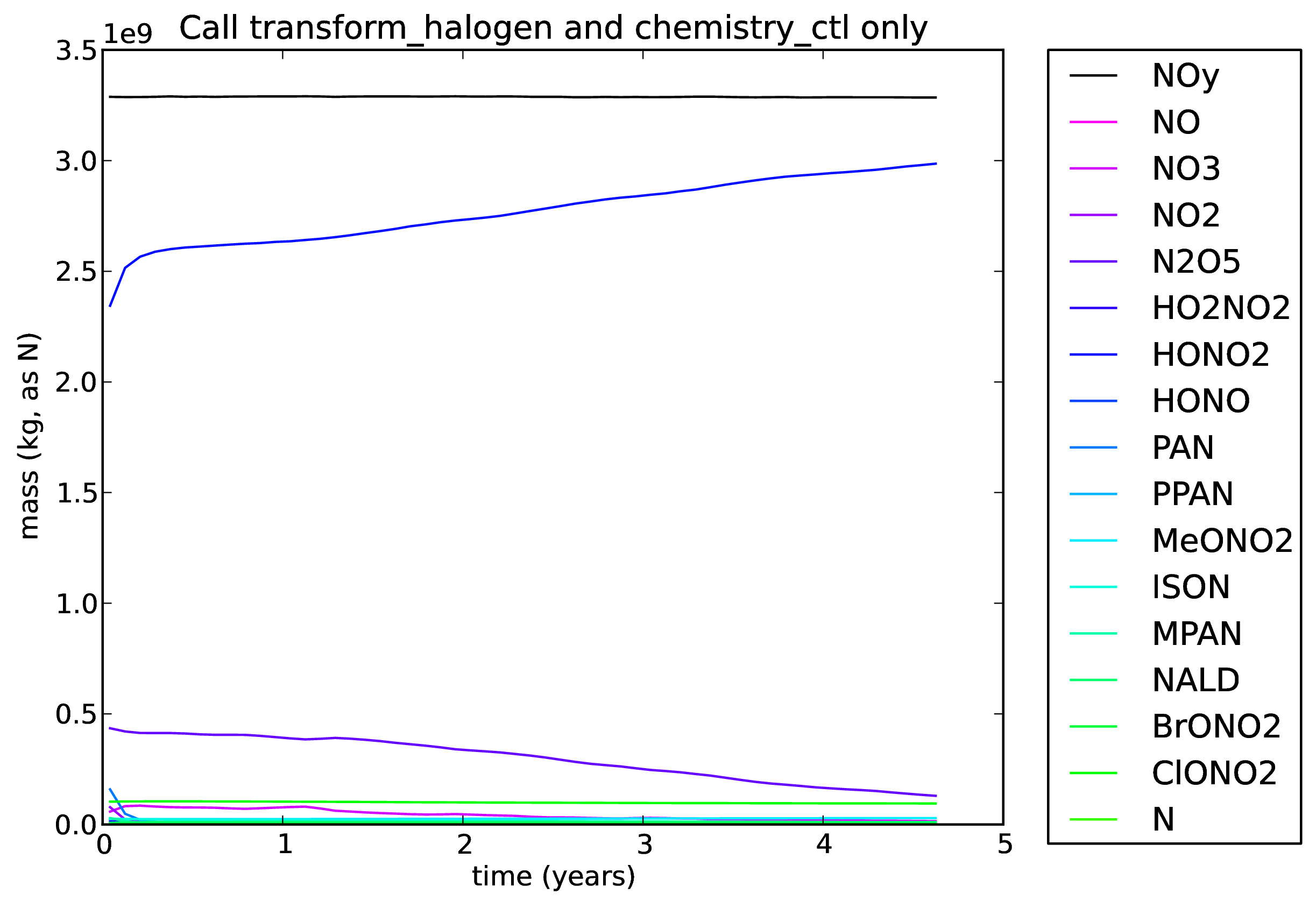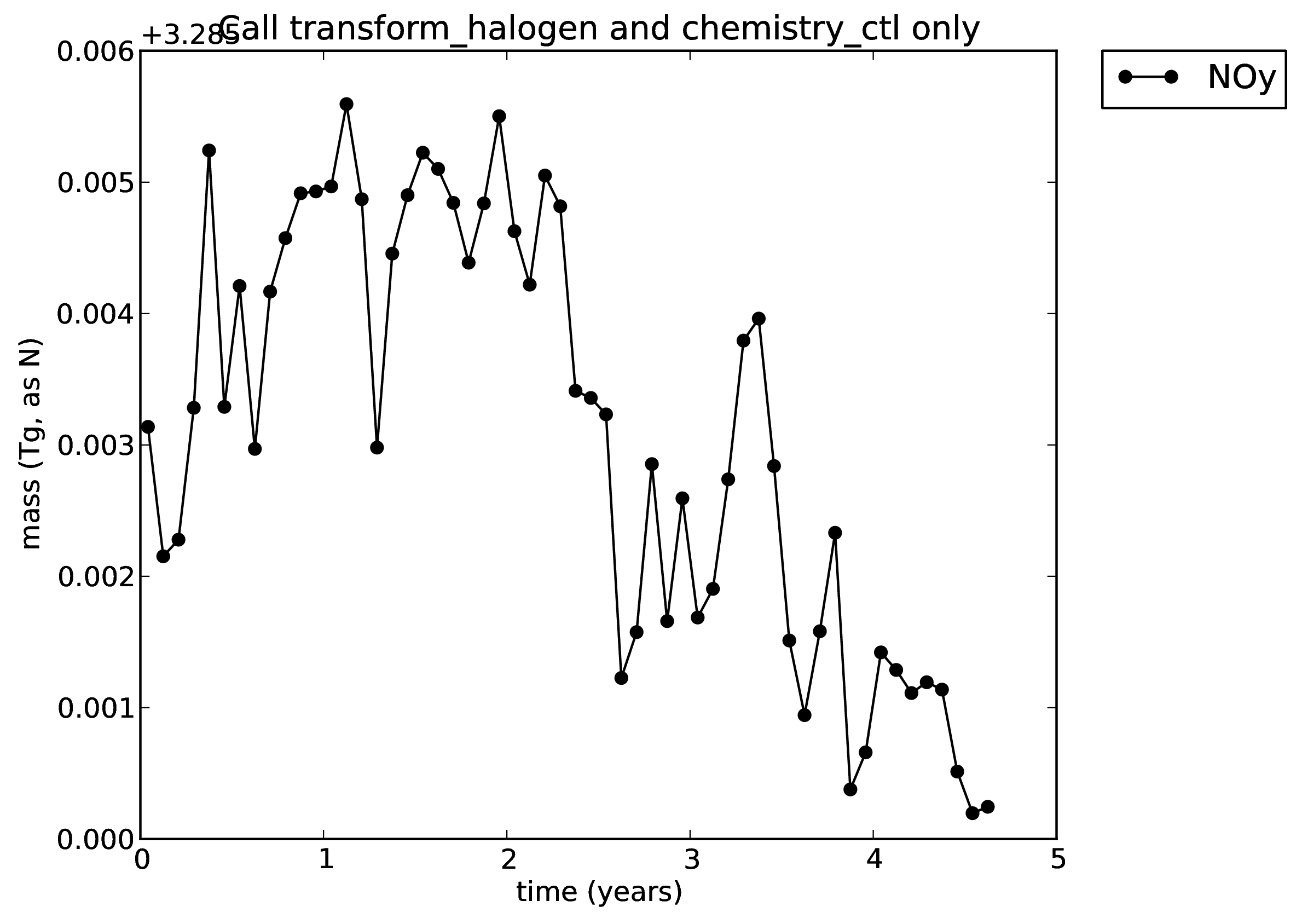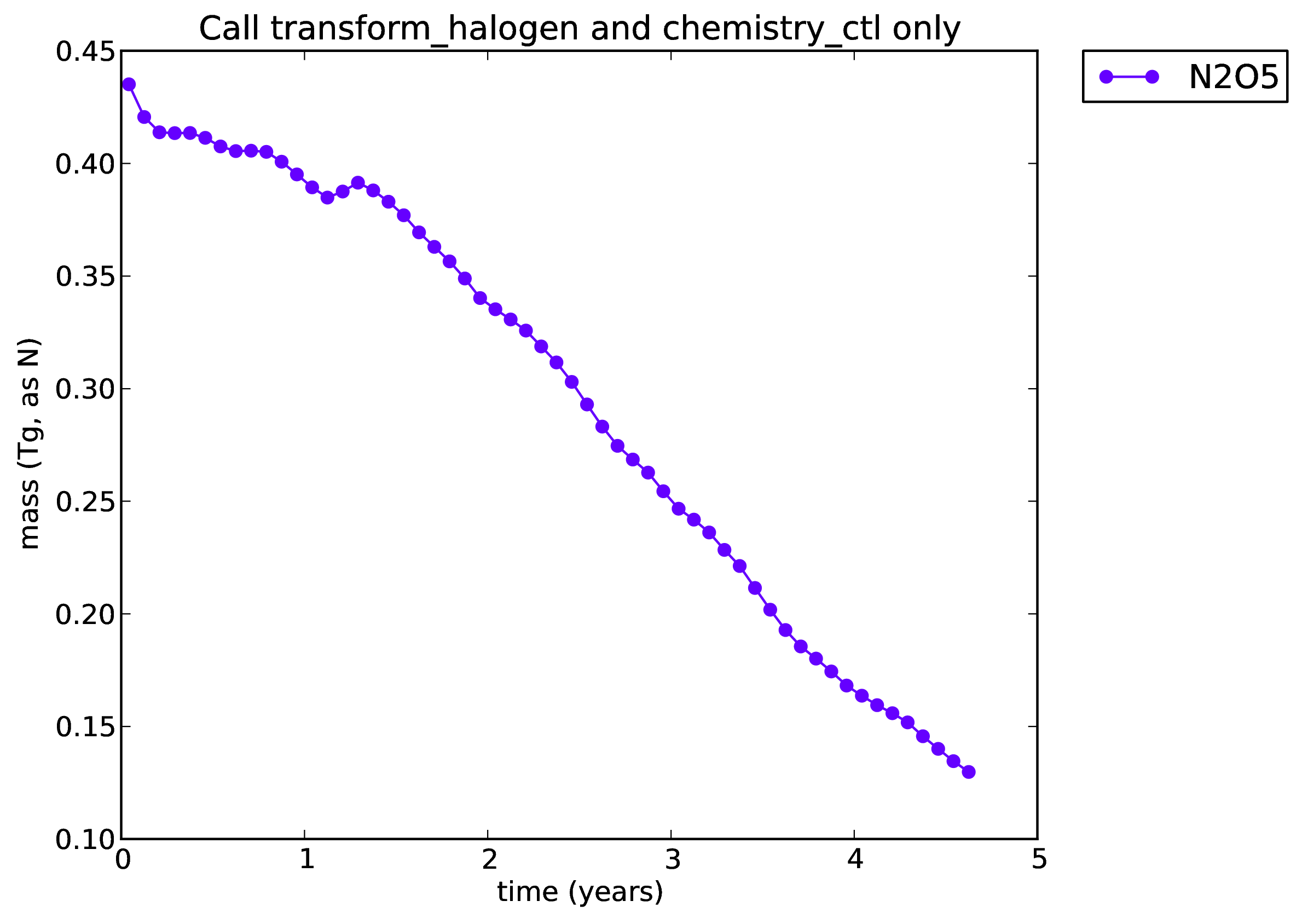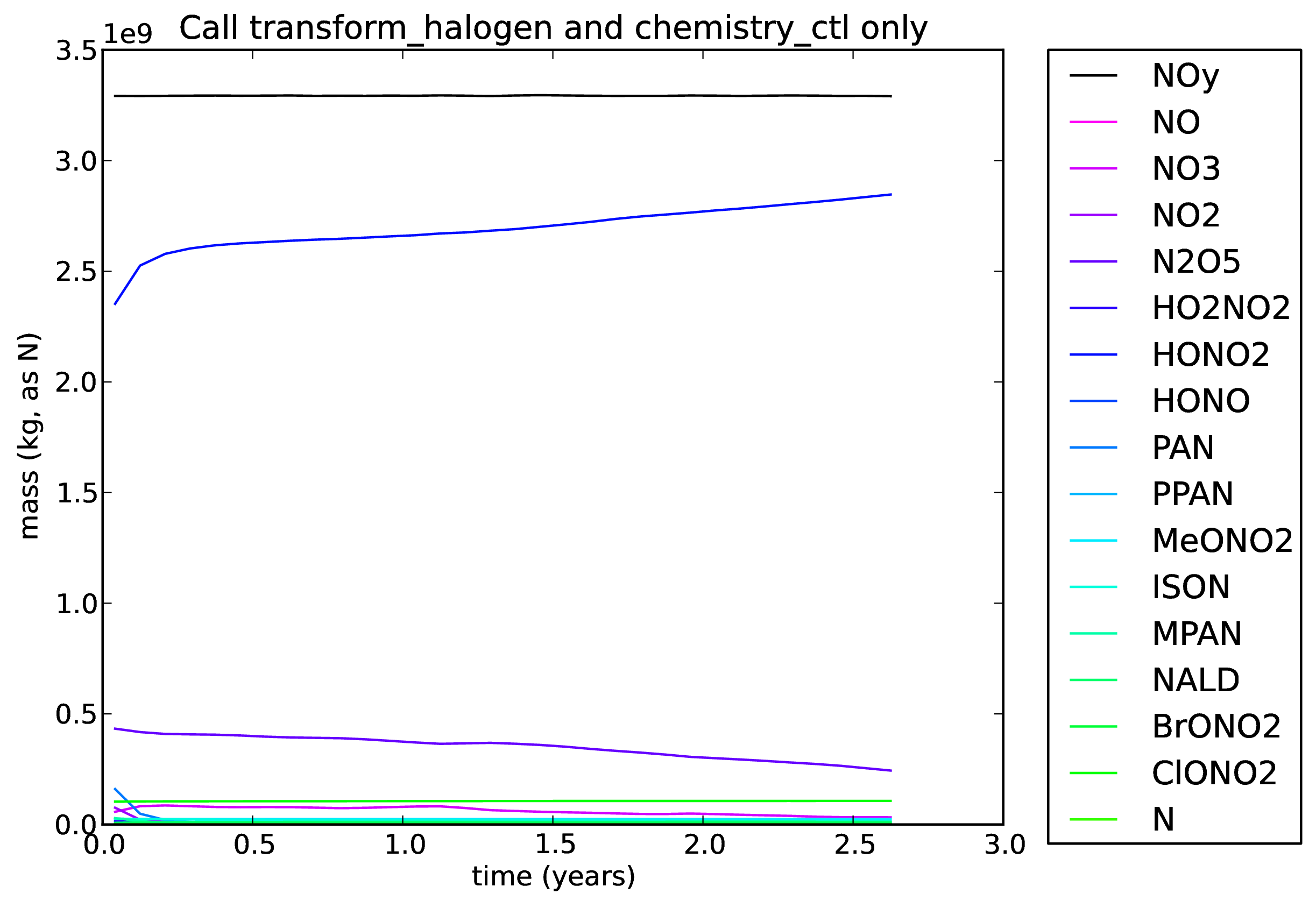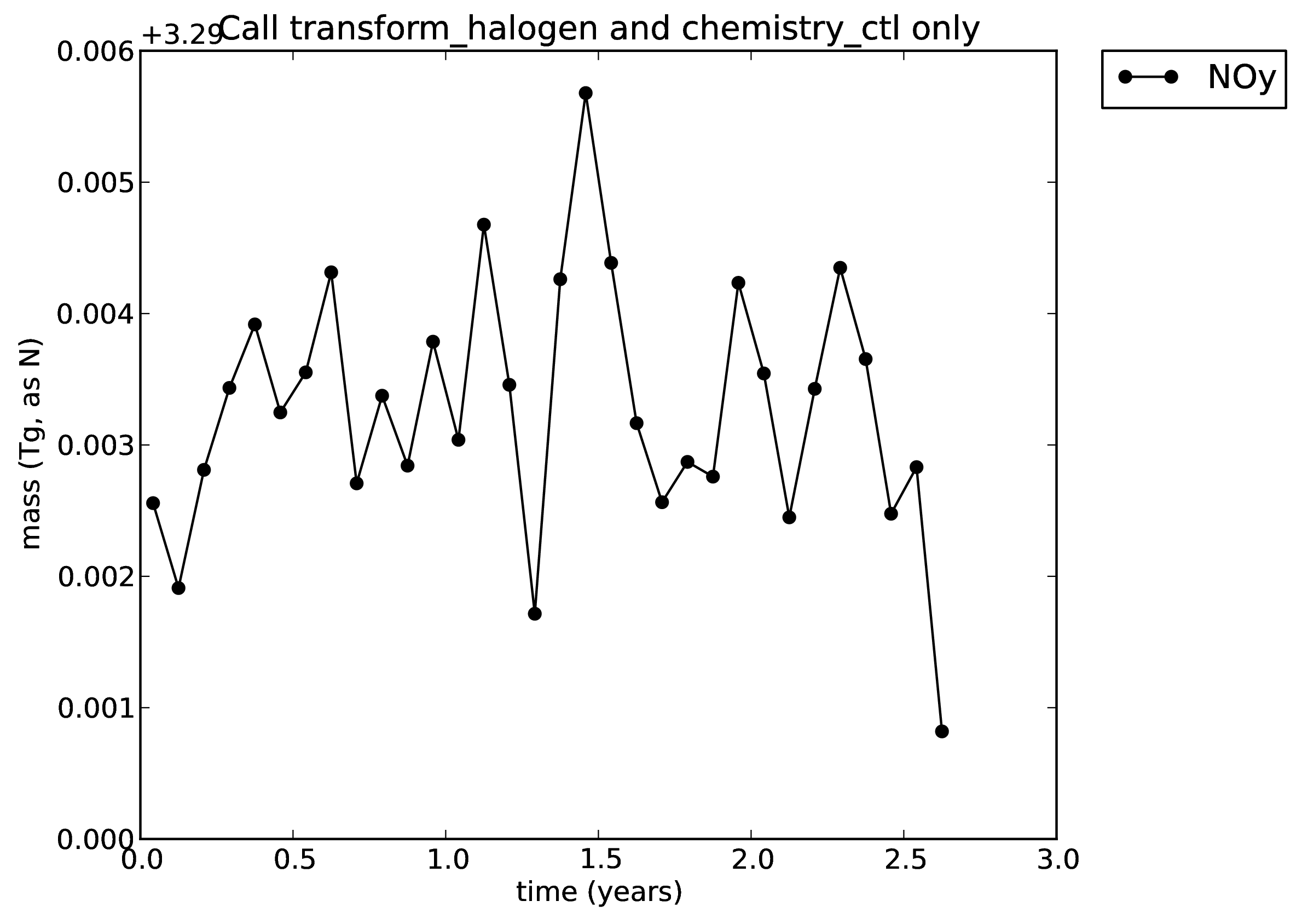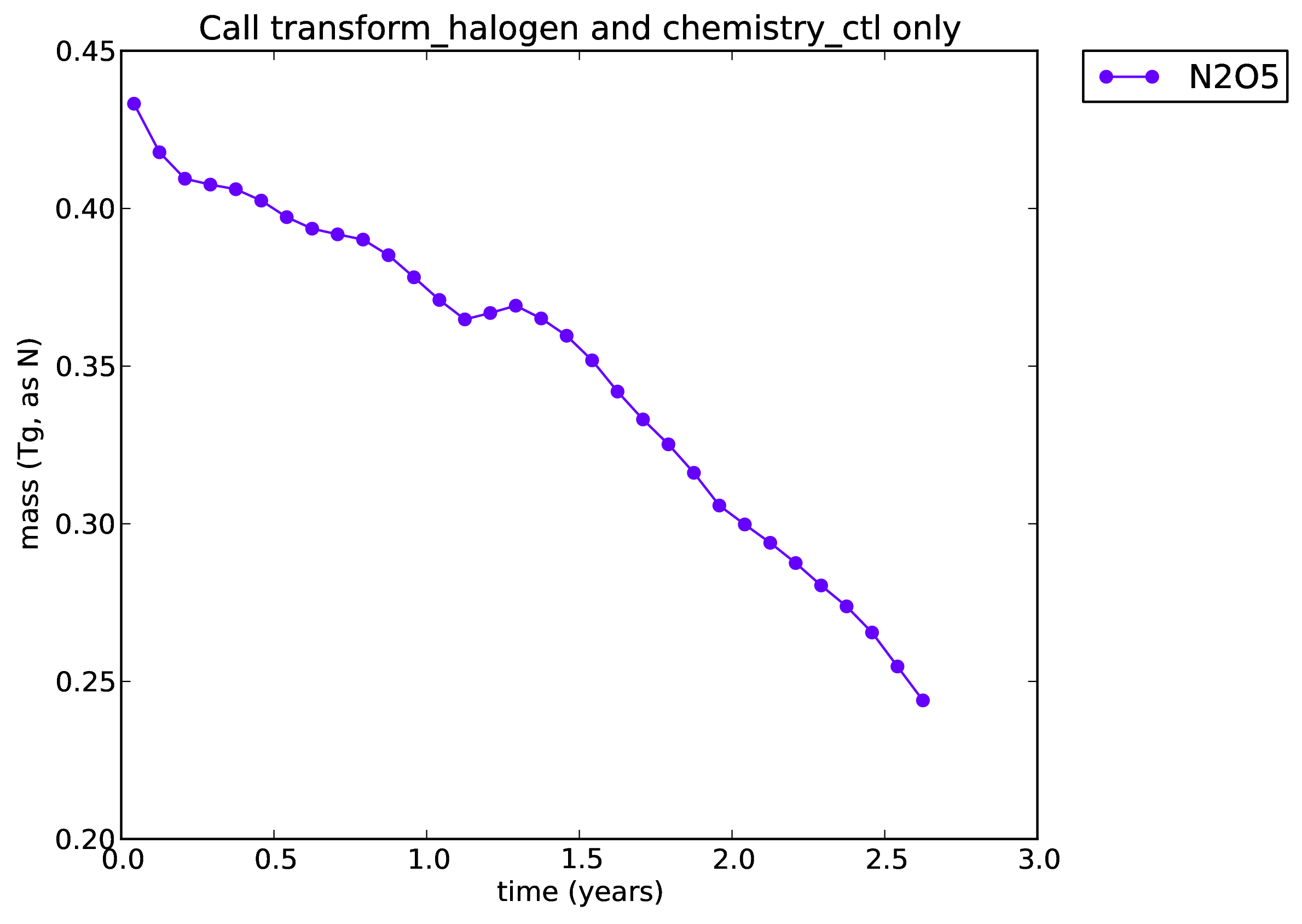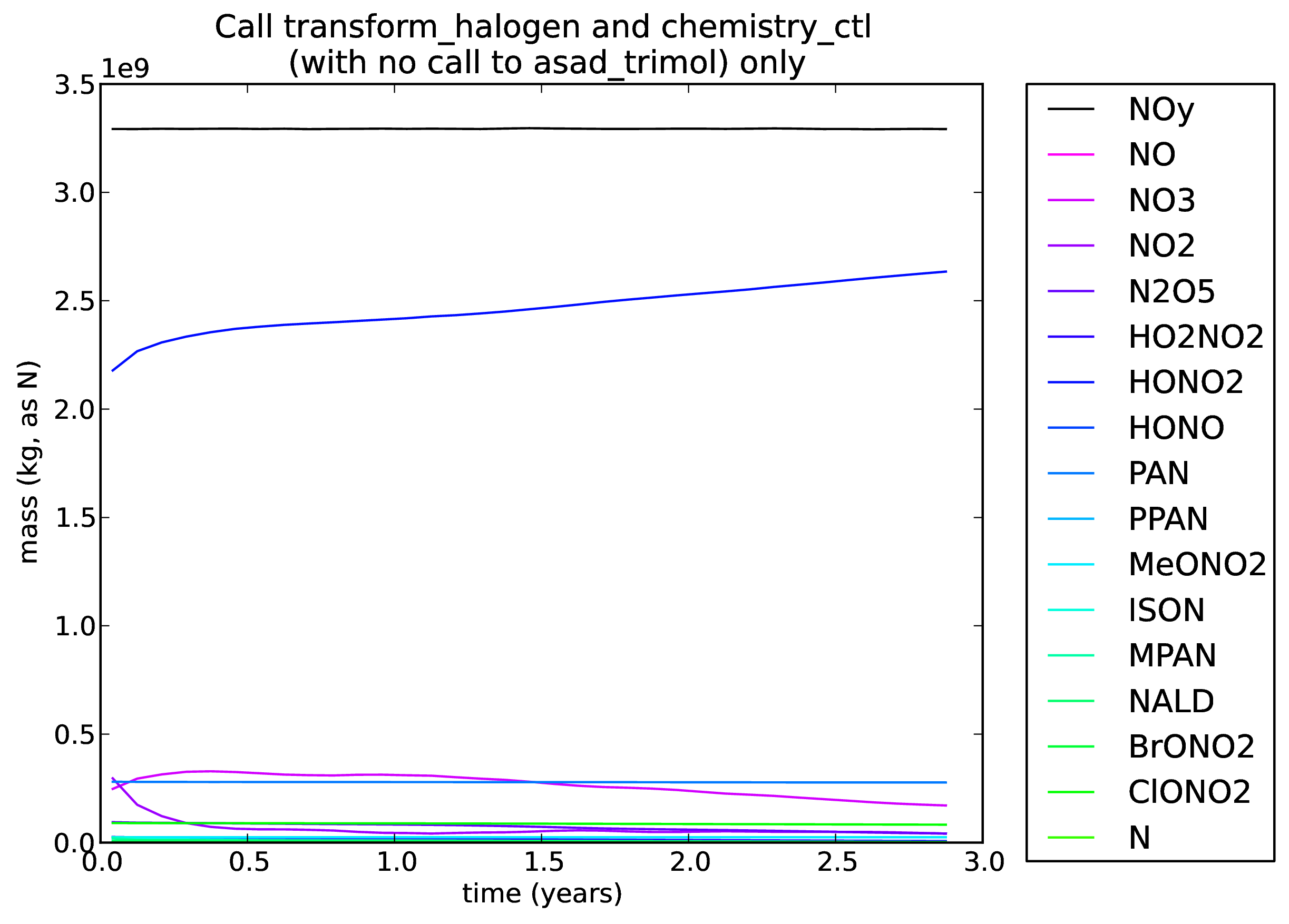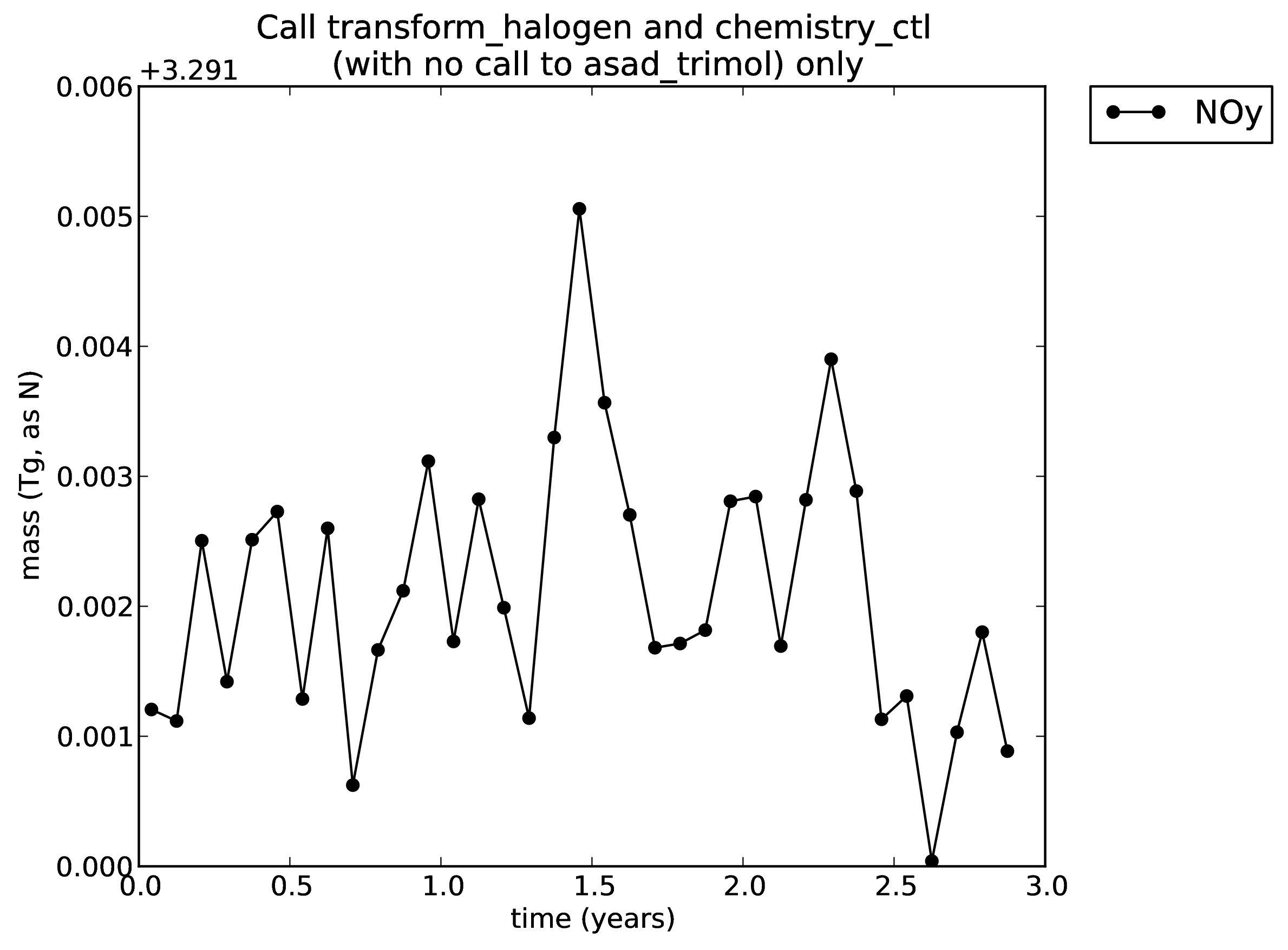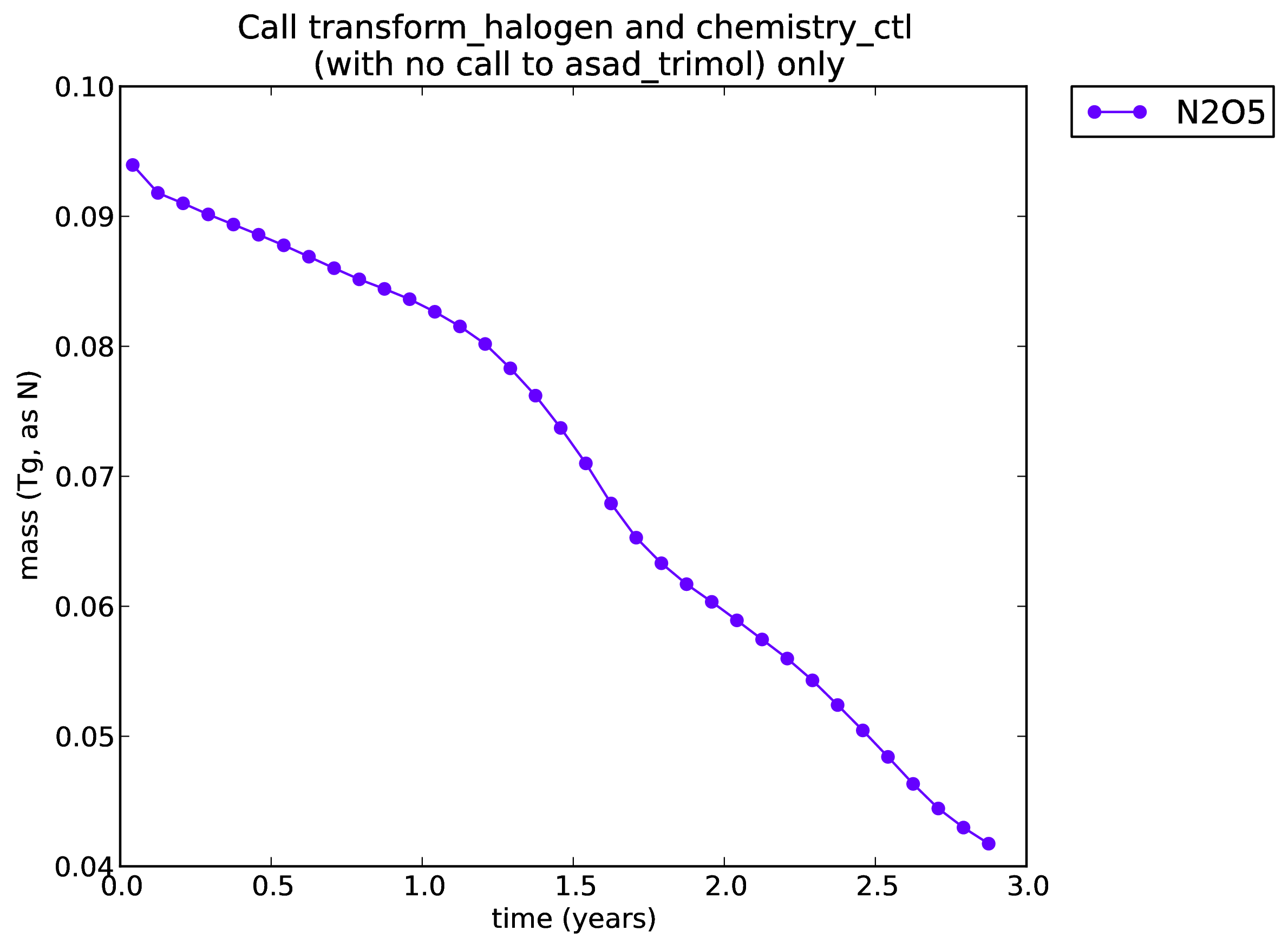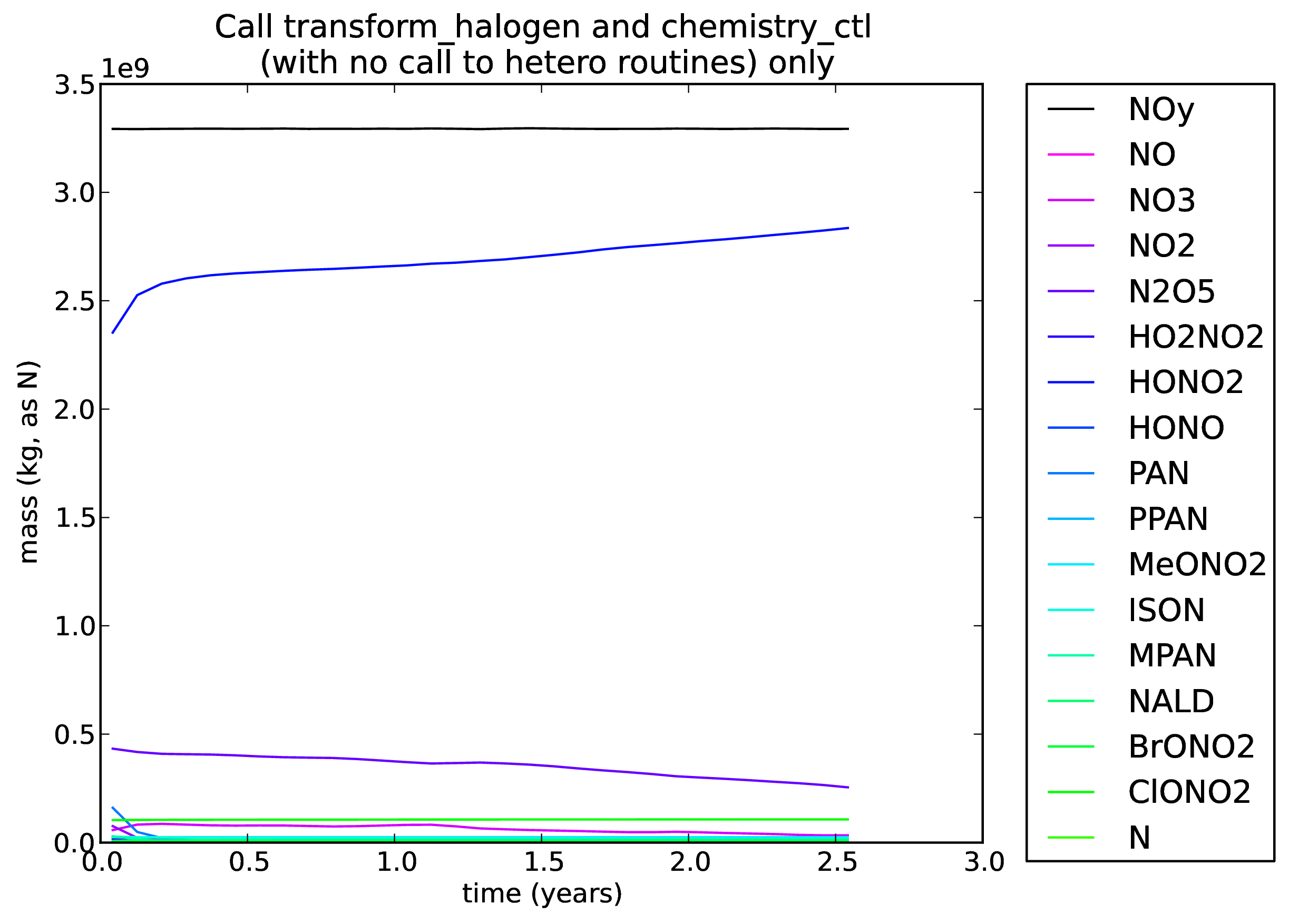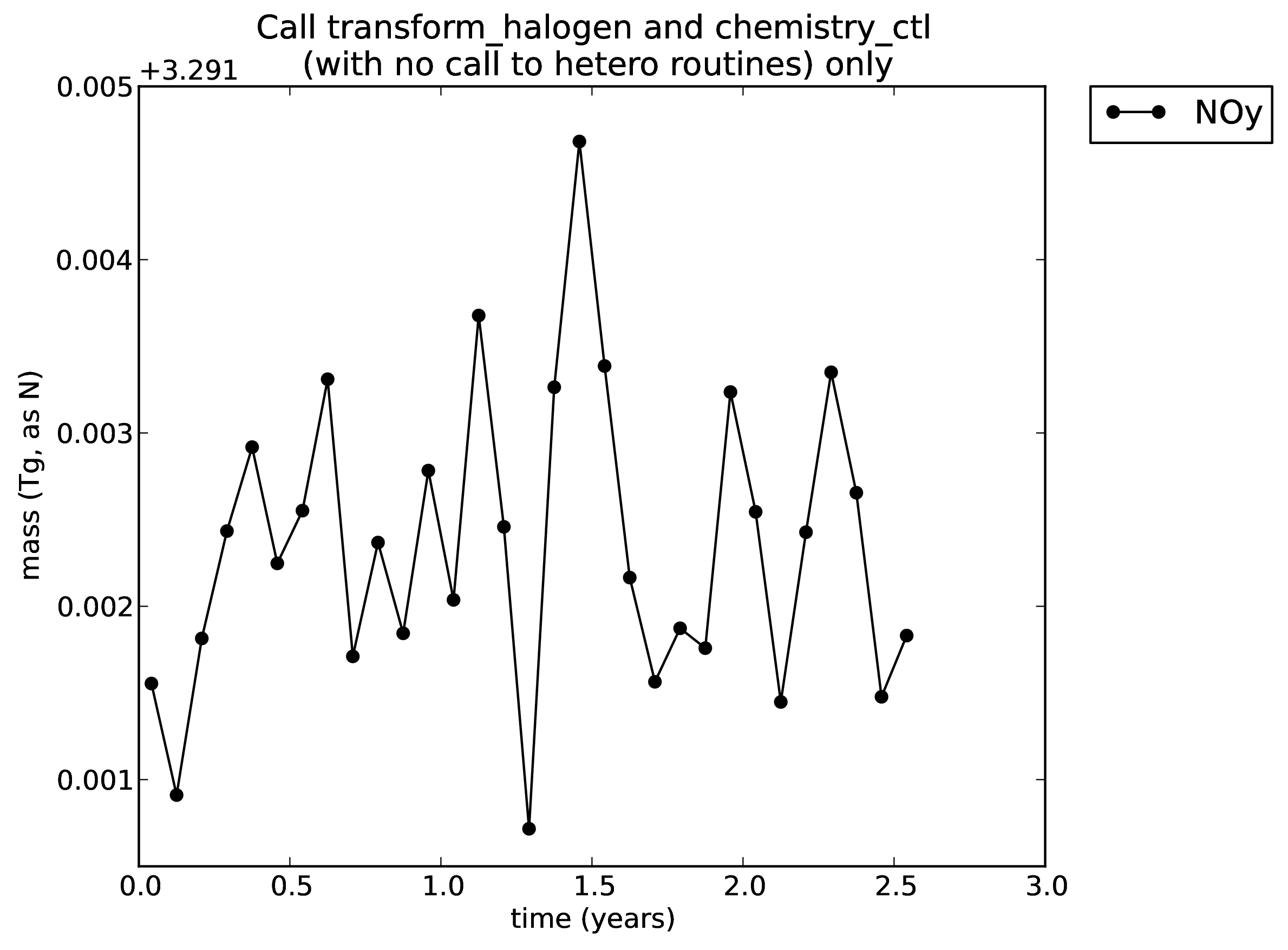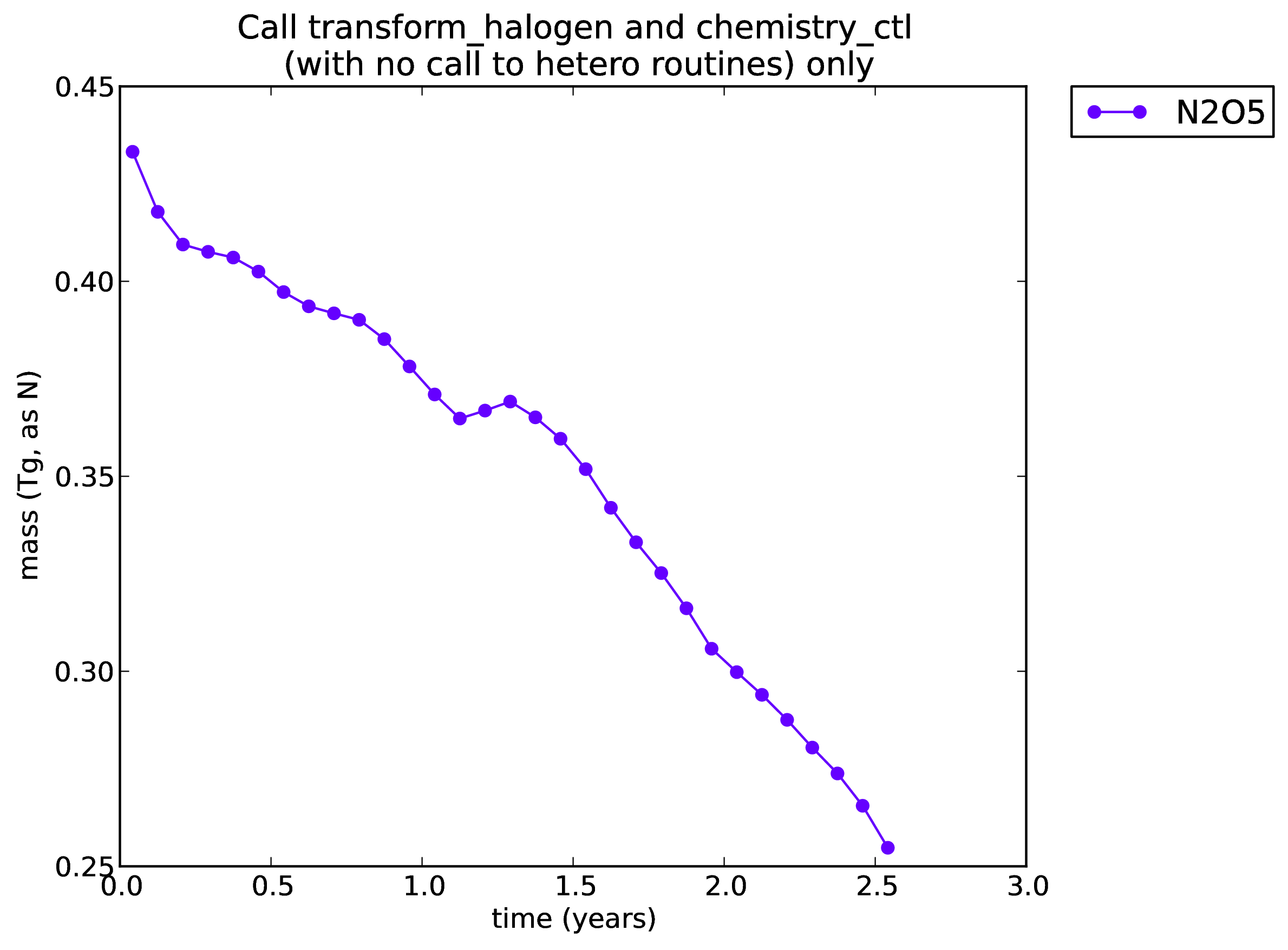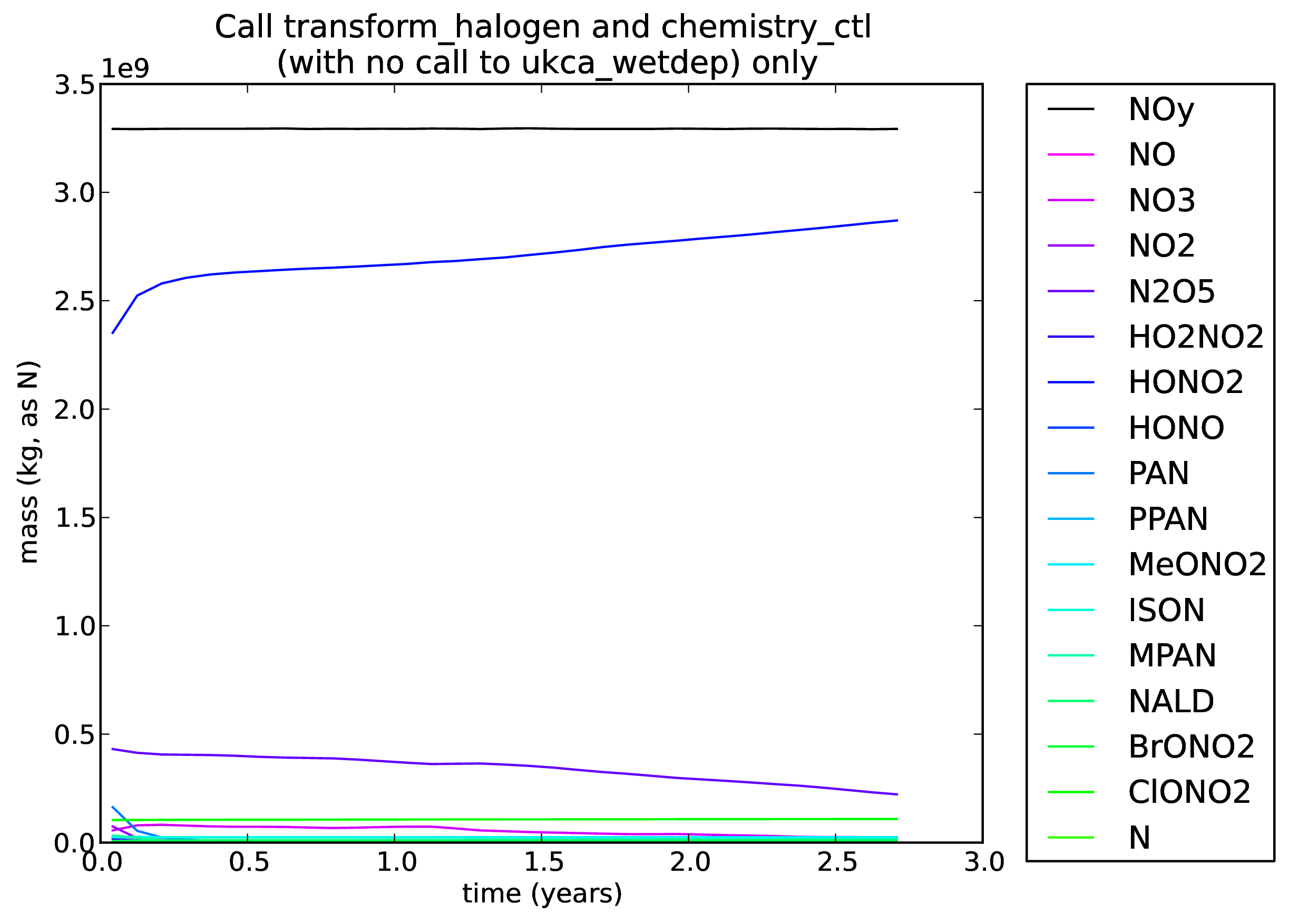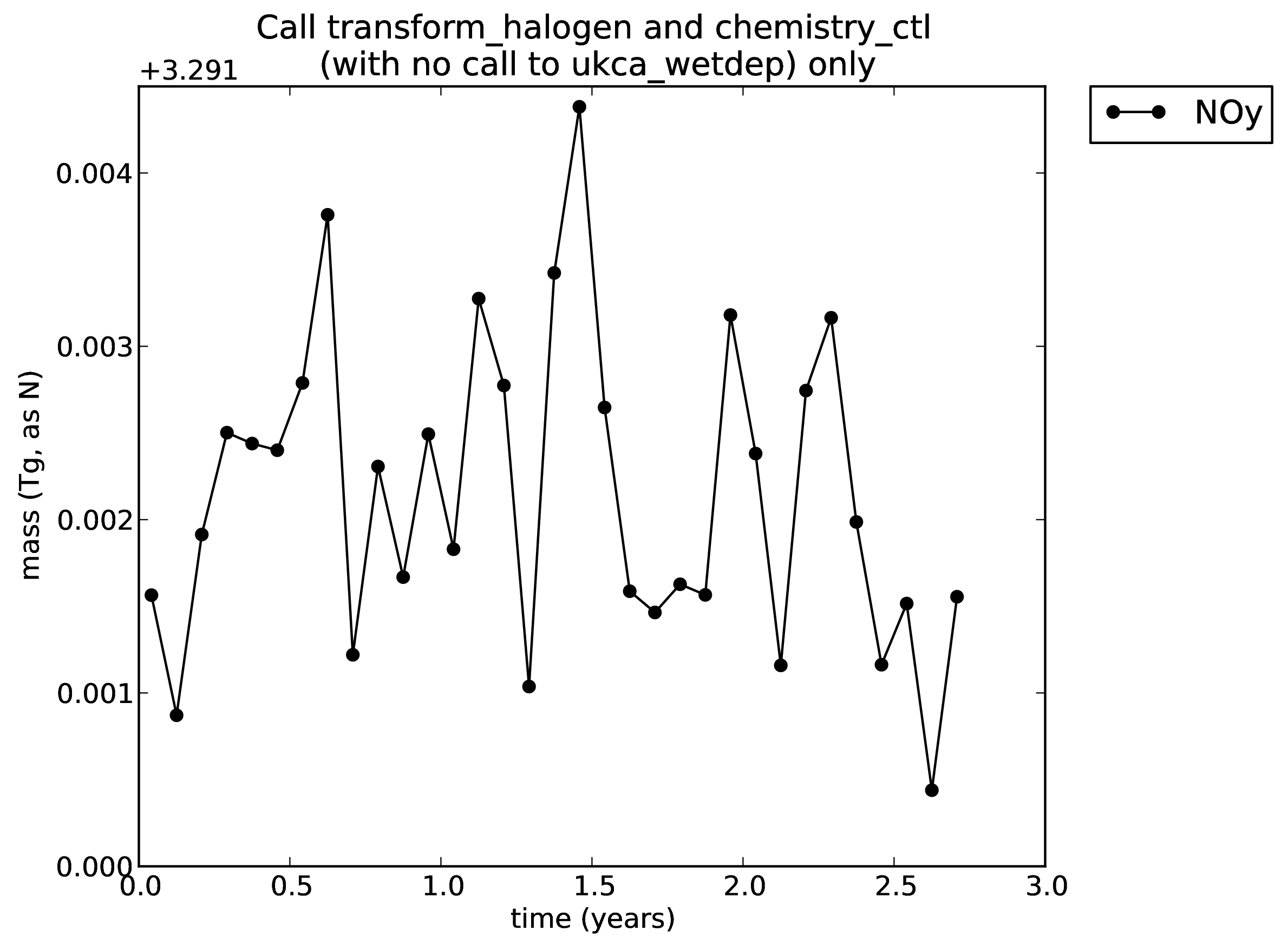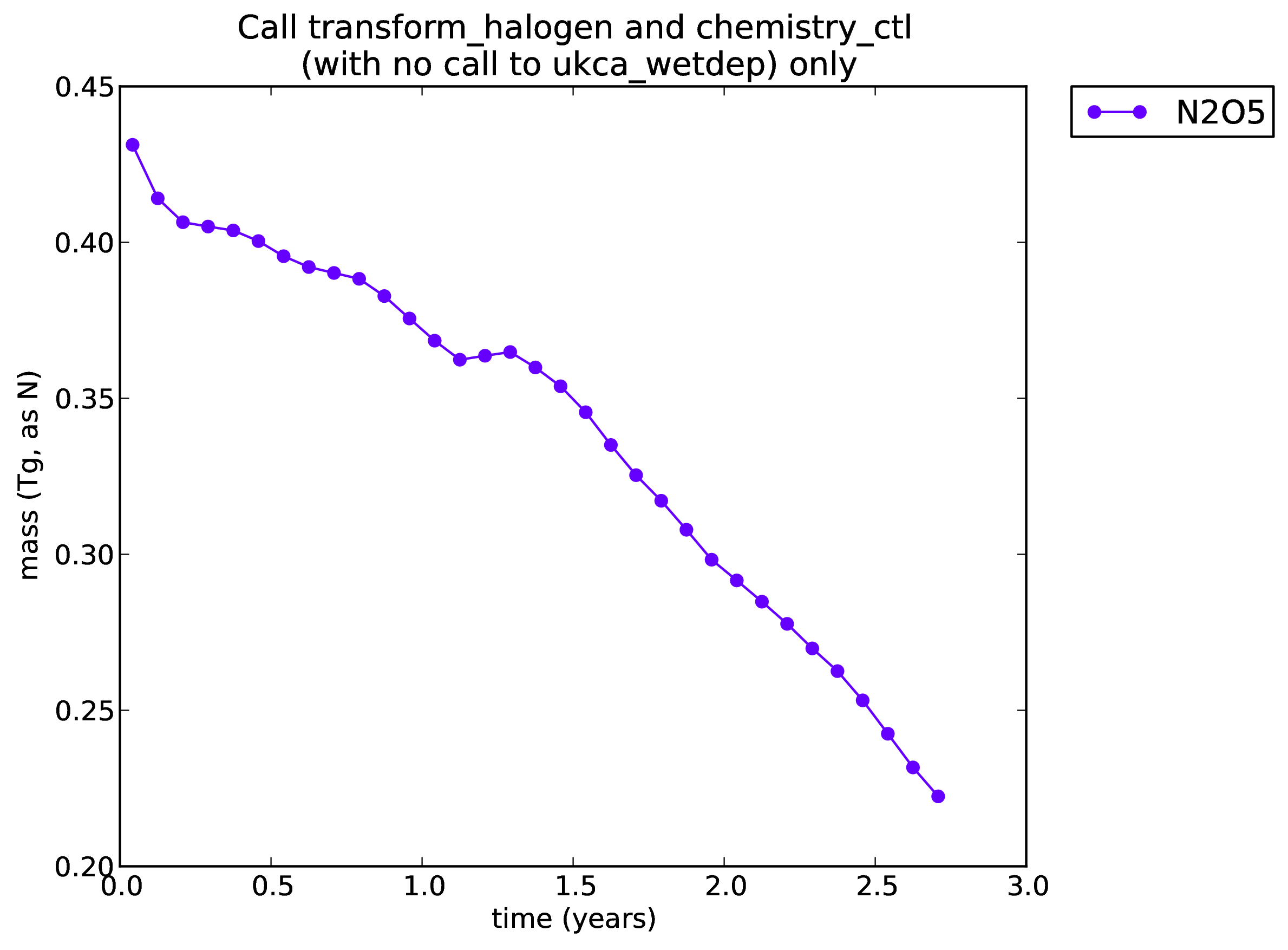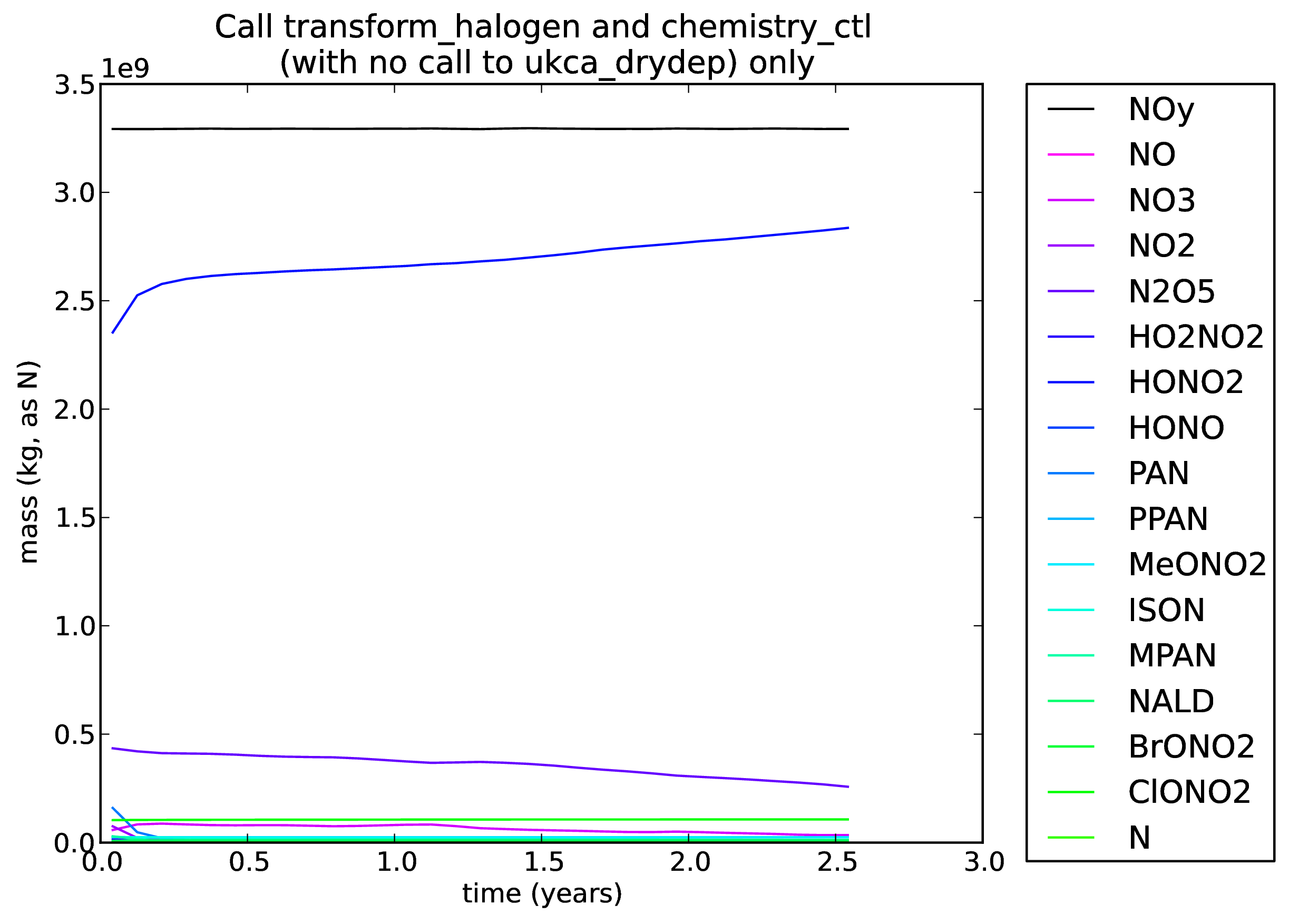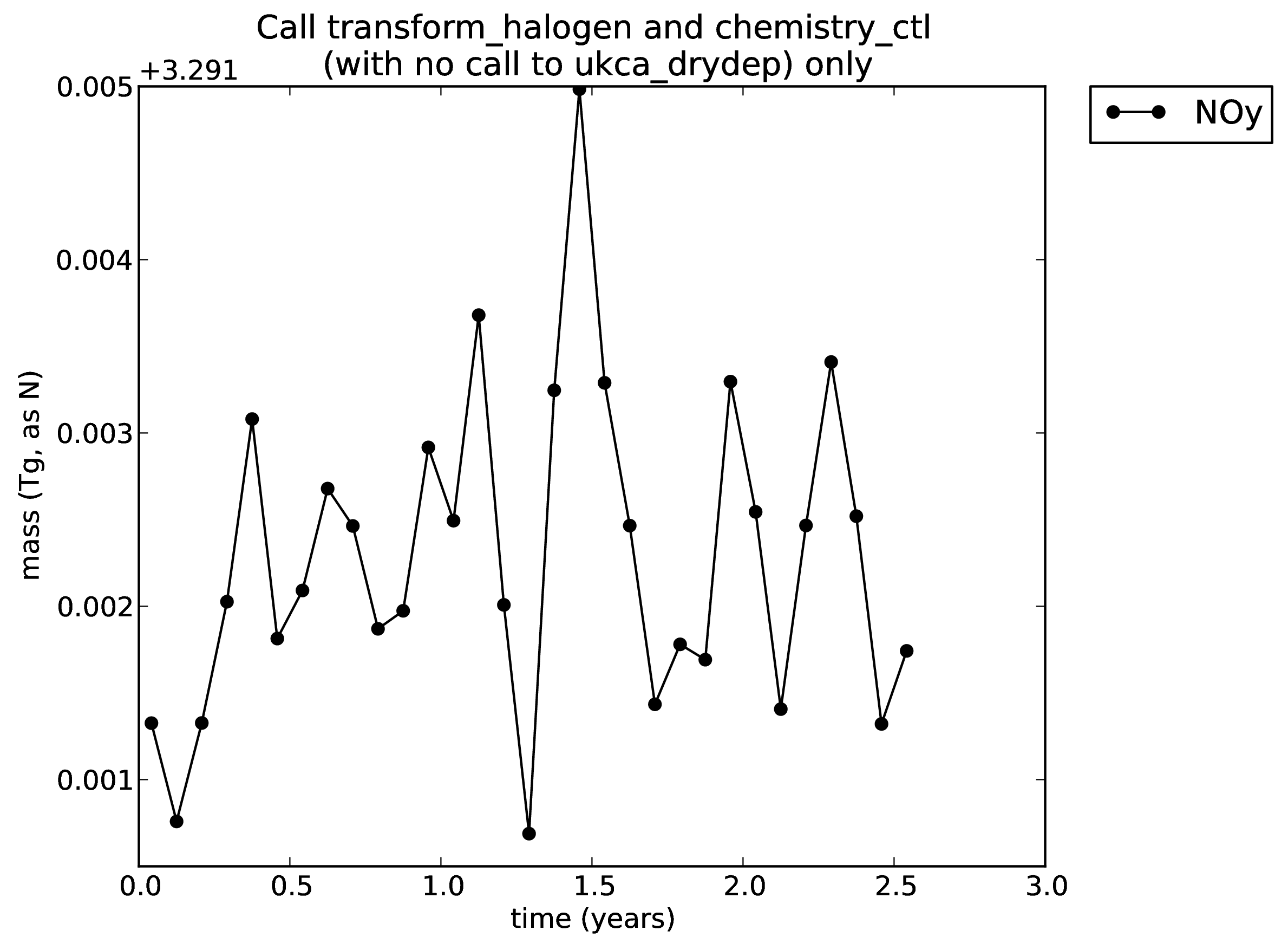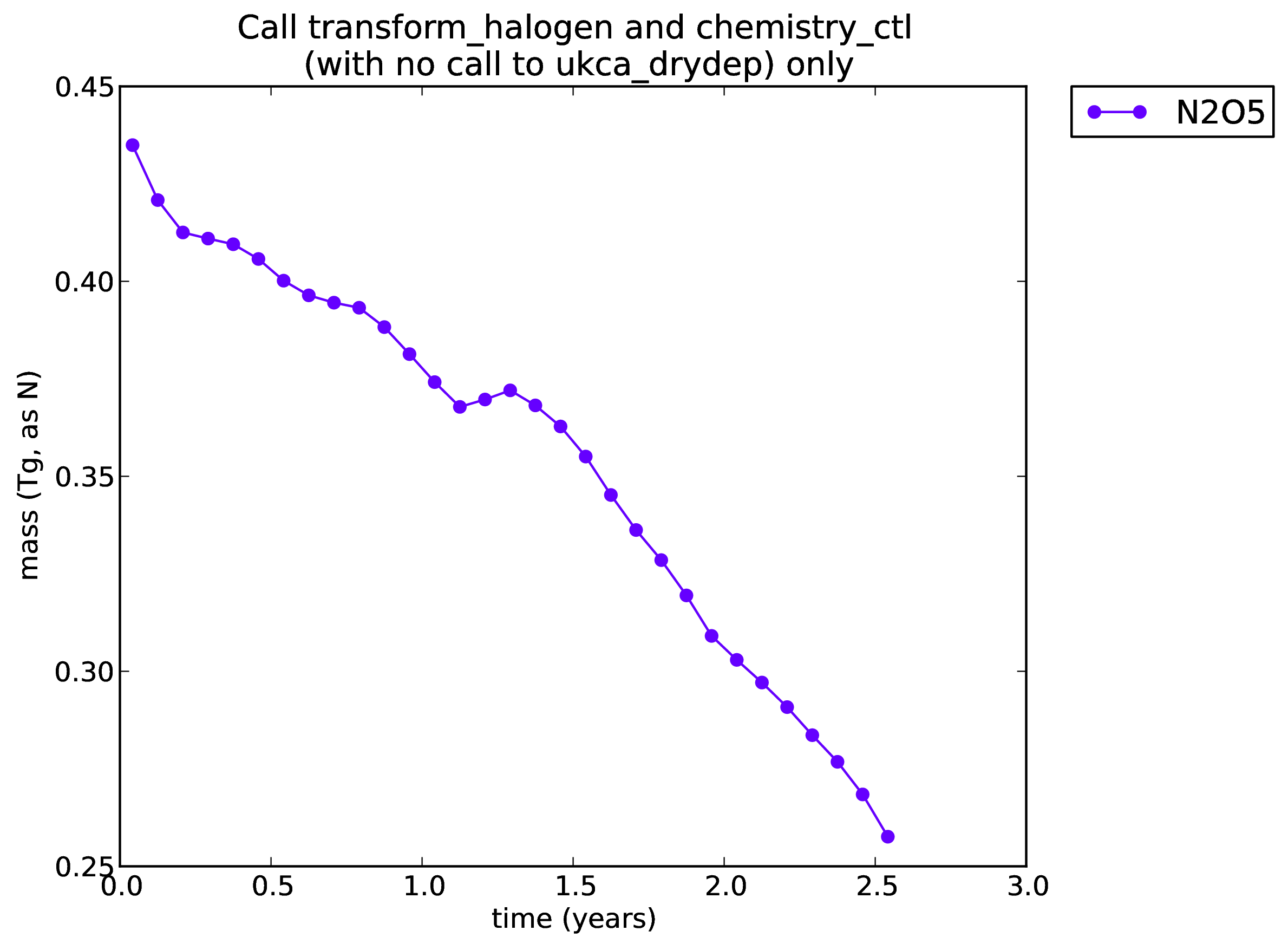vn7.3 vs. vn8.4
While UKCA had low NOy at vn7.3, this feature has not improved when moving to vn8.2/vn8.4 GA4.0 jobs, and may even have become worse.
A pair of simulations have been set-up to try to aid the diagnosis of the cause of this low NOy. While there have been many changes to the base atmospheric model, the differences between the UKCA chemistry scheme used have been minimised.
- All surface and aircraft chemical emissions are the same between both jobs, and are year 2000 climatologies
- The SST/Sea-Ice ancillaries are daily means from the Reynolds dataset, and are meaned over 1995-2005
- All chemical reactions and associated rates are the same between both jobs
- The GHGs and tracer lower boundary conditions are the same for both jobs
- 2000-12-01 from the CCMI REF-C2 specification taking WMO2011 values for ODSs and following the historical values for GHGs from the RCP scenarios defined for CMIP5
- The initial conditions of the chemical species are the same for both jobs, originally taken from a vn7.3 job. The winds and other physical initial conditions are different however
- Radiative feedback from O3 is included in both jobs
- vn8.4 job also considers radiative feedback from aerosols
- The same lightning NOx routine were used by both models, and these were scaled to give approximately the same annual emissions
NOTE: While the vn8.4 job does include GLOMAP-mode aerosols and some extra associated chemical reactions, the low NOy has also been observed in the vn8.2 CheST (only) configuration.
Results
| VN7.3 | VN8.4 | VN7.3 | |
| MONSooN jobid | xjcir | xjcin | xgywn |
| Configuration | HadGEM3-A r2.0 | HadGEM3-A GA4.0 | HadGEM3-A r2.0 (ish) |
| Resolution | N48L60 | N96L85 | N48L60 |
| UKCA scheme | CheST | CheST+GLOMAP | CheST |
| Model set-up | TS2000 | TS2000 | TS2000 |
| Evaluation Suite Output (Chemistry) |
|
| |
| Evaluation Suite Output (Aerosol) |
N/A |
| |
| NOy species time evolution | |||
| Comparison with SLIMCAT | |||
| Stratospheric Flux Analyis | |||
| Lightning NOx |
year 01 4.31451 Tg(N)/year |
year 01 3.93965 Tg(N)/year |
NB The stratospheric analysis pdf file contains a table of the annual sum throughout the stratosphere (moles /yr) for all reactions that produce or destroy a chemical species in the run. The pdf is sorted alphabetically (Br first PPAN at the end).
Minutes from meeting 2014-02-13
- Present
- Luke Abraham (NLA), Alex Archibald, James Keeble (JMK), Sandip Dhomse, Paul Griffiths, Martyn Chipperfield, John Pyle, Fiona O'Connor (skype)
- Further experiments suggested
- Change how the NOy species are treated: removed these from transform_halogen and make a new routine which also requires NO2 to be transported. The NOy (i.e. Lumped N) tracer is also advected and this is used as a test against the calculated NOy field from the individual species. Using this comparison the NOy species can be rescaled according to the ratio of and . BrONO2 and ClONO2 should not be rescaled as this would change the Cl and Br species. A diagnostic check on the differences between and should be done, as well as possibly checking for global conservation during transport. The NALD tracer is not currently included and should be. (NLA to do)
- Further to the above, try turning off all other processes and check the advection over a short run. Other steps could then be added piecewise to see their effects.
- Check that N2O5 is not causing any problems by setting its rates to zero and set it to no_change in transform_halogen (JMK to do)
Sensitivity tests
NLA has performed several sensitivity tests following the meeting and the recommendations above.
Note that for the plots below, NOy was calculated by summing up all the other species in post-processing.
An example of the problem is:
Changes required to below plots
The plots below are rather confusing, and there are a lot of them. The following changes will be made, but unfortunately not for the teleconference on the 15th December:
- Change the units so that all species are plotted in kg(N). Currently all plots are in kg(Species) except for NOy.
- Include the initial value from the .astart file in the plots, to give the initial condition. This should highlight some of the strange behaviour in NOy.
The results from these tests are:
1. transform_nitrogen routine
The NOy components of transform_halogen were removed, and implemented in a separate routine. Now, NO2 and lumped NOy are also advected and instead of NO2 being the residual instead a calculated_NOy field is computed from the separately advected NOy species, and this is compared to the transported_NOy field. The differences here are then used to tweak the NOy species that all allowed to be changed by the routine (currently, not ClONO2 and BrONO2). This is job xjcis.
The image below shows the evolution of the total atmospheric mass of each of the NOy species, in kg(species). Note that NOy is given in kg(N).
The model is still spinning up slightly from the initial condition.
2. Doubled HNO3
A copy of xjcis (and so transform_nitrogen was still used) was taken and the HNO3 initial condition was doubled (contribution also included in NOy) to bring the values up to what should be expected. This is job xjcit.
The image below shows the evolution of the total atmospheric mass of each of the NOy species, in kg(species). Note that NOy is given in kg(N), and the shorter x-axis.
The run was stop after only a few years as the HNO3 mass dropped rather quickly. The NOy mass also drops.
3. No production or loss of any NOy species
A copy of xjcit was taken (i.e. including the doubled HNO3 initial condition and using tranform_nitrogen). All sources and sinks of any NOy species were removed, i.e. no deposition, emissions, or sedimentation. All reactions were still included if they interconverted between NOy species, but any reactions which produced or removed NOy were not included. This is job xjciv.
The image below shows the evolution of the total atmospheric mass of each of the NOy species, in kg(species). Note that NOy is given in kg(N).
There is some interesting structure in the evolution of several of the species. These can be highlighted if required. While a lot of the species seem to have an exponential decay, others do not.
All plots from this run can be found here: ![]() NoSourceSink_xjciv.pdf
NoSourceSink_xjciv.pdf ![]()
4. No calls to any UKCA routines
A copy of xjciv was taken (including the doubled HNO3 initial condition), and calls to the transform_halogen/nitrogen, fastjx, emission_ctl, chemistry_ctl, and aero_ctl routines were removed. This is job xkqhb.
The image below shows the evolution of the total atmospheric mass of each of the NOy species, in kg(species). Note that NOy is given in kg(N), and the shorter x-axis.
This is as expected. The tracer transport scheme should be globally mass conserving, and it is. If it were not we would have had a bigger problem! This test also confirms that the problem is contained within UKCA itself.
All plots from this run can be found here: ![]() NoEmsChemAero_xkqhb.pdf
NoEmsChemAero_xkqhb.pdf ![]()
5. Call to ukca_emission_ctl only
A copy of xkqhb was taken (including the doubled HNO3 initial condition), and call to emission_ctl was included again (there were still no calls to the transform_halogen/nitrogen, fastjx, chemistry_ctl, and aero_ctl). Note that there were no emissions into any of the NOy species in this run. This is job xkqhc.
The image below shows the evolution of the total atmospheric mass of each of the NOy species, in kg(species). Note that NOy is given in kg(N), and the shorter x-axis.
As well as showing that the emission_ctl routine isn't causing the problem, this also shows that it isn't coming from boundary layer mixing, either, as this is done in emission_ctl for the section 34 (UKCA) tracers.
6. Call to transform_halogen and transform_nitrogen only
A copy of xkqhb was taken (including the doubled HNO3 initial condition), and the forward and backward calls to transform_halogen and transform_nitrogen were included again (there were still no calls to the emission_ctl fastjx, chemistry_ctl, and aero_ctl). This is job xkqhd.
The image below shows the evolution of the total atmospheric mass of each of the NOy species, in kg(species). Note that NOy is given in kg(N), and the shorter x-axis.
There are some corrections to the NOy species initially (these probably go down as the horizontal gradients are smoothed out during the run). However, NOy remains mostly constant and does not drop by very much.
All plots from this run can be found here: ![]() TransOnly_xkqhd.pdf
TransOnly_xkqhd.pdf ![]()
7. Call to transform_halogen, transform_nitrogen, and chemistry_ctl only
A copy of xkqhd was taken (including the doubled HNO3 initial condition), and, as well as the forward and backward calls to transform_halogen and transform_nitrogen, the call to chemistry_ctl was included again (there were still no calls to the emission_ctl fastjx, and aero_ctl). While FastJX was not used (the rates from this routine were set to zero), there is still a contribution to the photolysis rates from the lookup table scheme in the upper levels of the model. This is job xkqhe.
The image below shows the evolution of the total atmospheric mass of each of the NOy species, in kg(species). Note that NOy is given in kg(N), and the shorter x-axis.
There should be changes to the NOy species, which may involve them increasing or decreasing during the course of the run. The important thing here is that NOy changes as well.
As there is no photolysis or emissions, the evolution is different from the original no sources or sinks run. This implies that the problem is in chemistry_ctl, or in the combination of chemistry_ctl and transform_nitrogen.
Looking at the figures below for NOy and N2O5 in more detail, it appears that the drop in both is highly correlated (after the first few months), more-so than with other species. Note the different scales on the y-axis.
Also, the initial mass of NOy seems around 25% higher in this run than in the other runs, despite the fact that they all started from the same initial condition. It is unclear why the value is higher here.
8. Call to transform_halogen and chemistry_ctl only
A copy of xkqhe was taken (including the doubled HNO3 initial condition), and the calls to transform_nitrogen were removed. The forward and backward calls to transform_halogen and chemistry_ctl were still included (there were still no calls to the emission_ctl fastjx, and aero_ctl). The photolysis rates were completely set to zero in this simulation. This is job xkqhf.
The image below shows the evolution of the total atmospheric mass of each of the NOy species, in kg(species). Note that NOy is given in kg(N), and the shorter x-axis.
As above (xkqhe), there should be changes to the NOy species, which may involve them increasing or decreasing during the course of the run. The important thing here is that NOy changes as well.
As there is no photolysis or emissions, the evolution is different from the original no sources or sinks run. Given that transform_nitrogen is not called in this run, this implies that the problem is in chemistry_ctl alone, and is not associated with photolysis.
Looking at the figures below for NOy and N2O5 in more detail, it appears that the drop in both is still highly correlated (after the first few months), more-so than with other species. Note the different scales on the y-axis.
Also, the initial mass of NOy still seems around 25% higher in this run than in the other runs, despite the fact that they all started from the same initial condition. It is unclear why the value is higher here, but it is not associated with transform_nitrogen.
All plots can be found here: ![]() ChemOnly_xkqhf.pdf
ChemOnly_xkqhf.pdf ![]()
9. Call to transform_halogen and chemistry_ctl (with no call to asad_trimol) only
A copy of xkqhf was taken (including the doubled HNO3 initial condition). The forward and backward calls to transform_halogen and chemistry_ctl were still included (there were still no calls to the transform_nitrogen, emission_ctl fastjx, and aero_ctl). The photolysis rates were completely set to zero in this simulation. The call to asad_trimol was commended out in asad_cdrive, which means that there will be no termolecular reactions at all in this simulation. This is job xkqhg.
All plots from this run can be found here: ![]() NoTrimol_xkqhg.pdf
NoTrimol_xkqhg.pdf ![]()
10. Call to transform_halogen and chemistry_ctl (with no call to hetero routines) only
A copy of xkqhg was taken (including the doubled HNO3 initial condition). The forward and backward calls to transform_halogen and chemistry_ctl were still included (there were still no calls to the transform_nitrogen, emission_ctl fastjx, and aero_ctl). The photolysis rates were completely set to zero in this simulation. The call to asad_trimol was put back in in asad_cdrive, but all heterogeneous routines in asad_cdrive were commented out. This is job xkqhh.
All plots from this run can be found here: ![]() NoHetero_xkqhh.pdf
NoHetero_xkqhh.pdf ![]()
11. Call to transform_halogen and chemistry_ctl (with no call to ukca_wetdep) only
A copy of xkqhh was taken (including the doubled HNO3 initial condition). The forward and backward calls to transform_halogen and chemistry_ctl were still included (there were still no calls to the transform_nitrogen, emission_ctl fastjx, and aero_ctl). The photolysis rates were completely set to zero in this simulation. The calls to the heterogeneous routines in asad_cdrive were put back in, but the call to ukca_wetdep was commented out, meaning that there will be no wet deposition of any species. This is job xkqhi.
All plots from this run can be found here: ![]() NoWetDep_xkqhi.pdf
NoWetDep_xkqhi.pdf ![]()
12. Call to transform_halogen and chemistry_ctl (with no call to ukca_drydep) only
A copy of xkqhi was taken (including the doubled HNO3 initial condition). The forward and backward calls to transform_halogen and chemistry_ctl were still included (there were still no calls to the transform_nitrogen, emission_ctl fastjx, and aero_ctl). The photolysis rates were completely set to zero in this simulation. The call to ukca_wetdep in asad_cdrive was put back in, but the call to ukca_drydep was commented out, meaning that there will be no wet deposition of any species. This is job xkqhj.
All plots from this run can be found here: ![]() NoDryDep_xkqhj.pdf
NoDryDep_xkqhj.pdf ![]()
Planned Tests
There are a number of planned tests:
- Double N2O+(O1D) rate as done at vn7.3
- Run the NoSourceSink (xjciv) in 2 new ways:
- Set all rates of NOy involved reactions to zero
- Remove all NOy involved reactions
The latter two should give equivalent results, assuming that there is no overwriting being done in asad_bimol or asad_trimol.
New Results
A number of others tests were run, listed below. When plotting these, it was realised that the NO2 contribution had not been included in the original plots above - this has now been corrected.



